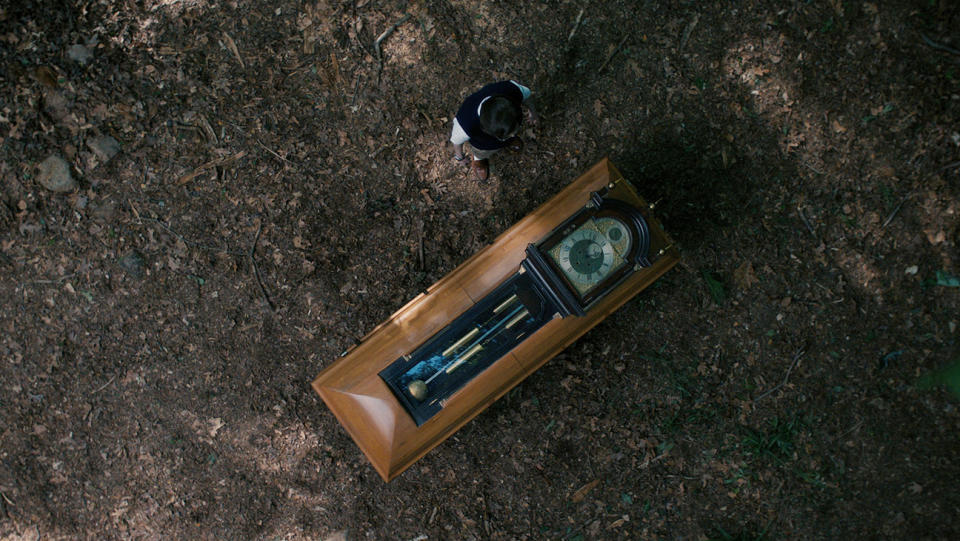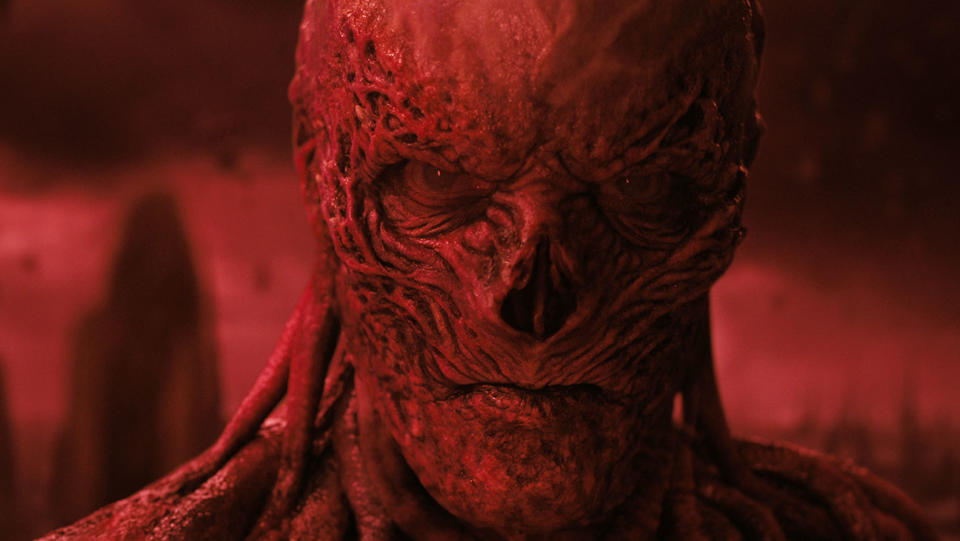Tick, Tock: How ‘Stranger Things’ Found Season 4’s Haunting Sound
- Oops!Something went wrong.Please try again later.

[This story contains major spoilers from the fourth season of Stranger Things, Volume 1.]
The Stranger Things audience still has a sound from season four ringing in their ears. After terrorizing the teens of Hawkins in the first part of the latest season of the hit Netflix series, the chime of a grandfather clock is now haunting viewers.
More from The Hollywood Reporter
Jamie Campbell Bower on the 'Stranger Things 4' Twist Reveal
Catherine Reitman's 'Workin' Moms' to End With Upcoming Season 7 on CBC, Netflix
The eagle-eared viewer may realize they’ve heard the sound of a clock before when it comes to Stranger Things villains. The eerie sound that has come to be associated with season four’s Upside Down villain, Vecna — who is revealed to be “One” (Jamie Campbell Bower) in the Volume 1 finale — first chimed in season two’s “Chapter Four: Will the Wise” with Hopper (David Harbour) discovering a tunnel to the Upside Down, and again in the season three episode, “Chapter Two: The Mall Rats,” when Billy (Dacre Montgomery) was being possessed by the Mind Flayer.
Was Stranger Things signaling Vecna’s impending arrival? Not so fast.
Not even Craig Henighan, the show’s Emmy-nominated sound designer since season one who led the team on creating Vecna’s soundtrack, realized that he had already created the start of the gong sound that would have such a reverberating effect in season four.
“I actually used the chime, and I didn’t really know this until I thought about it,” Henighan, re-recording mixer and supervising sound editor, tells The Hollywood Reporter. “I still remember Shawn [Levy, executive producer and director] listening to it and being like, ‘Is that a clock? Why do we have a clock in there?’ But Matt and Ross [Duffer, creators] really liked it and we just went with it. At that time, I didn’t know the clock we have in season four was going to be such a storyline.”
The clock ends up playing a large role, as it signals Vecna’s arrival and that time is running out. The Upside Down monster, who is revealed to be the first child patient with telekinetic powers in Dr. Brenner’s (Matthew Modine) Hawkins Laboratory program that Eleven (Millie Bobby Brown) is later a part of, evolves into the slithering, psychological demon that viewers meet in season four after Eleven, as a younger child, overpowers him and banishes him away into the hidden world of Hawkins, where he would go on to hone his powers for years. When he re-emerges in season four, he does so by infiltrating the minds of his victims and preying on their trauma. His victims know they are being hunted when the grandfather clock and its ominous chime appear in hallucinations.

Courtesy of Netflix
As a creative starting point each year, the Duffer Brothers provide Henighan with adjectives to describe the season. If season three was “gore,” season four is “psychological.” From those early conversations, Henighan says he and his sound team took the descriptor and ran with it.
“This season’s sound is almost a touchstone of what we as humans get really piqued on and really freaked out by. A lot of times, it’s not the big, aggressive, gory horror sounds, it’s the simplicity of a clock and the psychological thing of Vecna being in your mind and playing around with your memories,” he says of his team’s task with the penultimate season, which was released in two parts, with the final two episodes that make up Volume 2 releasing July 1.
“All of these ideas are born out of the realistic nature of sounds, but we bend them into the world of Stranger Things. You Stranger-ize it a little bit: What makes it feel like it’s part of our world?” he says. “Because we’ve done so many seasons now, there’s a fantastic palette of signature sounds with the Upside Down. Now, we can add the clock and Vecna to that list.”

Courtesy of Netflix
Henighan initially put the most pressure around creating Vecna’s voice. “I want it to go down in a historical context of bad guys,” he says of Bower’s monster living among cinema villain royalty.
Bower put hours into crafting the right voice, which the sound team then took over in editing. “This voice has to hit a certain way coming out of speakers that makes everyone think: I know this bad guy. He’s going to be relentless and in my brain any time he speaks or is around.”
The sound designer says that, thanks to the natural pitch and frequencies in Bower’s voice, he was able to quickly come upon the right processing chain to make Vecna sound menacing yet understandable. “If you can’t understand him, it doesn’t matter how the processing works,” he points out. “He’s not supernatural; he’s not super deep and growly. He’s just got this really rad-sounding processing [voice effect] that is just chilling.”
And while Henighan knew the clock sound that accompanies him would play a big role in Vecna’s legacy and lore, he’s taken aback by the passionate reaction from the Stranger Things audience, which helped the show score two record binge-watching weekends on Netflix and gave a soaring streaming life to the Kate Bush 1985 song “Running Up That Hill (A Deal With God).”
“There’s YouTubers out there who made an hour- or two hour-long video of that clock with a still picture of the clock from one of the episodes. You can go to sleep to it now,” he muses. “And someone else made a ringtone.”
In the first episode, which begins with victim No. 1, Chrissy (Grace Van Dien) and ultimately leads to new highschooler Eddie (Joseph Quinn) going on the lam, what viewers hear is a standard grandfather clock. To build the clock’s sound, Henighan began with a recording of a classic Westminster clock. That simplicity, says Henighan, was meant to help viewers wade into what’s to come — as the episodes get more revealing and Vecna’s victims list piles up, the base sound evolves.
“The brothers wanted to make sure everyone knew this was a clock and drive home that it’s not Stranger Things-ized yet. As the episodes carry on, like the scene with [victim No. 2] Fred [played by Logan Riley Bruner], we took the bell chime and I pitched it down six or eight semitones and I would adjust the pitch. If you listen closely, it lowers a pitch as it gongs. It does this sort of slow down and then gongs again, and we’re right back into the regular chime of it.”

Courtesy of Netflix
By the time someone from the main ensemble gets targeted, the sound ramps up. In the third episode, when Sadie Sink’s Max is haunted in the school hallway, the team began to play with the pitch-down gong effect and mix in other standard clock sounds. “If you take a cello and bow and strike the strings in a muted fashion, that’s what I’m using for the pendulum swinging. If you listen to it again, you’ll hear the strike of the cello bow when the pendulum is going left to right,” Henighan explains. “We’ll do that a lot in this show, where the sound will start regular and slowly morph into a Stranger Things sort of sound, which in this case, gives it this haunted, older and groanier sound.”
He also layered in another challenge for those eagle-eared viewers that connects the clock with the origin story of how One became Vecna: “The rift sound undulating underneath the clock in certain scenes is a call back to the rift later on when Eleven opens up the Mindscape [alternate dimension] and sends One into it, in episode seven.”
A key example of this Stranger Things sound evolution, he says, is how the source of the Demogorgon’s sound is actually recordings of seals. “We’ve morphed him so many ways now after three or four seasons that there’s a whole other language to what the Demogorgon sounds like now,” he says. “But the advantage of sound and storytelling is to use silence and quietness. So we haven’t forgotten our roots, but definitely things have gotten bigger and when it gets big like that cinematically, sound tends to follow and that’s where we end up in season four.”
It also doesn’t hurt that the fourth season has been reported to have the biggest budget yet. With the final two episodes clocking in at feature length (the finale, episode nine, is two-and-a-half hours long), Henighan and his team are currently in production on the sweeping conclusion of what has so far been a well-received darker, horror-esque turn of the coming-of-age series, and he says the final two episodes continue what Volume 1 set in motion.
“The last two episodes are just massive. All the pieces that have been building up pay off [in the final two episodes],” he says, careful not to give away spoilers. “There’s a whole giant showdown to come between Eleven and Vecna; they’ve teased that a little in the trailers.”
Expect Vecna’s sound to be more of the same, just bigger. And, of course, the clock is set to return.
“The clock has a massive storyline,” he teases. “It’s a rad cliffhanger where they left it. It’s actually the culmination of the last episode. And the clock has a big thing to do with it.”
Volume 1 of Stranger Things 4 is now streaming on Netflix, with Volume 2 coming July 1.
Best of The Hollywood Reporter

